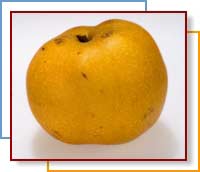
Asian pears are cousins to the pears that are typically seen in grocery
stores, but this fruit is similar to an apple and its many names reflect
that characteristic. Other names that this fruit goes by are: Chinese
pear, Japanese pear, Sand, Nashi, and apple pear.
|
|
Asian Pear |
Serving size
1 med. pear, raw (122g)
| Amounts
Per Serving |
% Daily
Value |
| Calories 50 |
|
| Calories
from Fat 5 |
|
| Total Fat 0g |
0% |
| Saturated
Fat 0g |
0% |
| Cholesterol
0mg |
0% |
| Sodium 0mg |
0% |
| Total
Carbohydrate 13g |
4% |
|
Dietary Fiber 4g |
14% |
|
Sugars 9g |
|
| Protein 1g |
|
| Vitamin A |
0% |
| Vitamin C |
8% |
| Calcium |
0% |
| Iron |
2% |
* Percent Daily Values are based on a
2,000 calorie diet.
|
|
| |
|
Asian pears differ from the traditional European ones. These pears are
usually round, firm to touch when ripe, and are ready to eat after harvest.
Asian pears reach prime quality when they ripen on the tree, like an apple
and peach. These pears will be crisp, juicy, and slightly sweet with some
tartness, especially near the core.
While European pears have the bulbous bottoms and tapering tops, they are
not ready to eat until they are slightly soft and must be picked during the
green stage and ripen at room temperature. European pears will be soft and
juicy, with a sweeter, mellower taste. European pears will be brown at the
core and an unpleasant taste if they are tree-ripened.
There are several Asian pear varieties available. Japanese pears are more
round in shape, while the Chinese pears are more oval or pyriform
(pear-shaped).
In the United States, the Japanese type of Asian pear called 20th Century
or Nijisseki is the most popular. It is easily identified with its round
shape and smooth yellow skin. Other common varieties include the Japanese
bronze-toned Hosui pear and the pear-shaped Ya Li, a pale-green Chinese
variety.
Select the most fragrant and unbruised fruit with little to no brown
spots. Ripe Asian pears are hard and do not soften. They are ready to eat
when purchased.
Asian pears are known for keeping well. Store pears a week at room
temperature or up to three months in the refrigerator.

Recipes
Asian Pear Slaw with Chilies
Makes 6 servings
Each serving equals 1/2 cup of fruit or vegetables
Source: Chris Faulkner for Melissa’s Variety Produce, Inc.
Ingredients
6 celery ribs
4 Tbsp fresh lime juice
4 Tbsp seasoned rice vinegar
1 tsp ginger root
6 Asian Pears, sliced ¼-inch thick
3 scallions, thinly sliced on diagonal
¼ cup Cilantro leaves
½ tsp Fresno chili or Jalapeno chili, finely chopped
Whisk together juice, vinegar, and ginger and stir in celery and
remaining ingredients with salt and pepper to taste. Let stand at room
temperature 15 minutes before serving.
Nutritional analysis per serving: Calories 67, Protein 2g, Fat 0g,
Calories from Fat 0%, Cholesterol 0mg, Carbohydrates 17g, Fiber 1g, Sodium
52mg.
Find more in our
recipe database!
|



